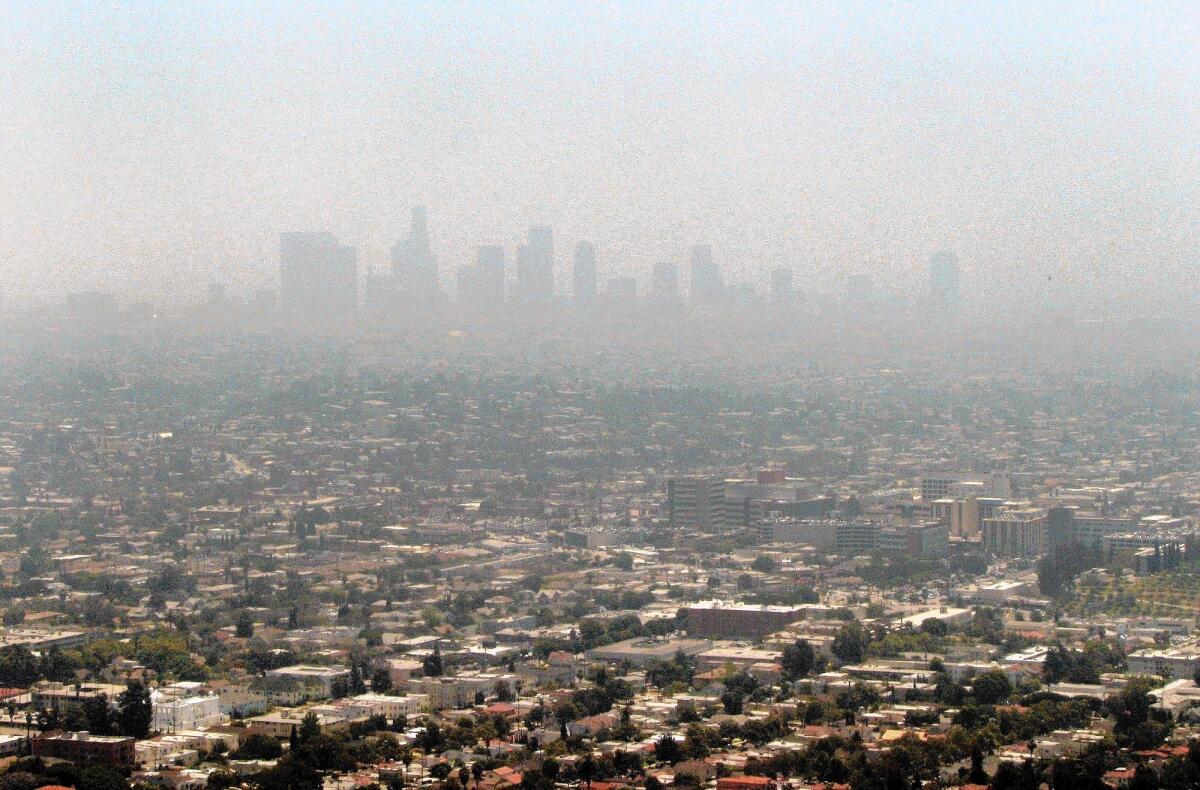EPA staff recommends significantly lower ozone standard

- Share via
The U.S. Environmental Protection Agency staff said Friday that the nation should tighten smog rules significantly, a step that would improve air quality in California but force costly new requirements on government and industry.
The EPA staff recommendation is the final step before the rule goes to the agency’s leadership and the White House. As a result of lawsuits by environmental and health groups, the agency must propose a new ozone rule by December and the final rule by October 2015.
Federal standards for ground-level ozone, the main ingredient in smog, have proved deeply contentious because they would compel many states, cities and industries to adopt new measures to cut air pollution at a cost of billions of dollars.
California would be particularly affected because much of the state does not meet the current, weaker standard for ozone that has been in place since 2008.
Ozone is a corrosive gas that forms when pollutants from vehicle tailpipes, power plants and factories bake in sunlight. The gas irritates lungs and airways and can cause asthma attacks, premature deaths, hospital and emergency room visits and millions of missed school and work days.
Pressure has been building for years from the scientific, health and environmental communities to reduce the federal standard for ground-level ozone to between 60 and 70 parts per billion. It is currently at 75 parts per billion, a standard set by the Bush administration that fell short of a recommendation for stricter limits from the EPA’s advisory committee of independent scientists.
The EPA science advisory committee in June recommended strengthening the ozone standard to the 60-to-70-parts-per-billion range, which the agency’s staff echoed in the findings issued Friday.
The committee said “ample scientific evidence” exists that ozone is harmful at lower levels than previously thought, citing studies showing it decreased lung function and increased respiratory symptoms and airway inflammation even at concentrations of 70 parts per billion.
The recommendations are part of a review the EPA is required to complete every five years under the Clean Air Act.
The Obama administration can choose to override the recommendations and adopt a weaker standard, including the current one. Facing enormous pressure from business in 2011, President Obama scuttled the EPA’s more stringent ozone rule, delaying it until after the 2012 presidential election.
But such a move today would likely trigger new litigation, said Paul Cort, a lawyer for Earthjustice, which sued the EPA to order it to issue the new standard.
California will face considerable challenges meeting a tougher ozone limit. The state has 16 areas that do not meet the current ozone standard, said Stanley Young, a spokesman for the state Air Resources Board. Lowering the standard would put even more areas out of compliance, many of them in rural areas, he said.
In California’s South Coast basin, which has the nation’s worst ozone pollution, a tougher federal standard would delay compliance with air quality standards further into the future. To meet the existing ozone standard of 75 parts per billion by a 2032 deadline, local air quality officials calculate they will have to slash by more than 75% smog-forming gases called nitrogen oxides.
“We’re going to need to have zero or near-zero emissions across the entire economy, from transportation to businesses, to residences and personal products,” said Sam Atwood, a spokesman for the South Coast Air Quality Management District, which includes Los Angeles and Orange counties.
The San Joaquin Valley also has some of the nation’s worst ozone pollution and is many years away from meeting existing standards.
Anticipating the recommendation, industry representatives and Republican members of Congress have launched a campaign focusing on the monetary costs of a tighter standard, which they argue would be ruinous to the economy.
The National Assn. of Manufacturers wrote “that a more stringent ozone standard from the Obama Administration could reduce GDP by $270 billion per year … increasing energy costs and placing millions of jobs at risk.”
The EPA staff recommendations swiftly drew criticism from Sen. James Inhofe (R-Okla.). “With the economy already showing signs that it is losing ground under the administration’s environmental regulations, now is no time to bow to the desires of the extreme environmental lobby here in Washington,” Inhofe said.
Supporters of a tighter standard said industry has long argued that environmental limits would destroy the economy but such predictions have failed to materialize.
“We’ve heard that argument for 40 years,” said Janice Nolen, assistant vice president of national policy at the American Lung Assn. “We have evidence showing it’s not true: Since the 1970s, we’ve reduced major air pollutants by 70% and the economy has more than doubled.”
[email protected]
Twitter: @neelaeast
[email protected]
Twitter: @tonybarboza








